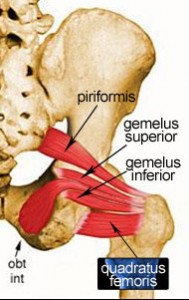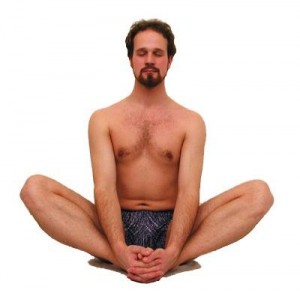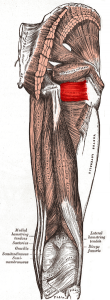Quadratus femoris is a small muscle in the area referred to as the groins. It is at the back of the pelvis, a bit lower than the piriformis. Like the piriformis it is a powerful external rotator that as a quadrate muscle also stabilizes the head of the femur in the hip socket.
Quadratus femoris is a powerful muscle that also tends to be fairly tight. If you lie down on your back, bring your feet together in a diamond and let your knees separate in supta baddha konasana, the stretch your feel is most likely quadratus femoris. It is usually the tone of the quadratus femoris that determines how high your knees are off the ground.
It originates from the ischial tuberosities, also the home of the hamstrings, adductor magnus and the sacrotuberous ligament, and inserts on the backside of the femur head and the backside of the femur bone. The importance of this muscle is magnified because of it intimate physical relationship with the hamstrings and the inner thighs.
There is also an interesting relationship with another quadrate muscle, quadratus lumborum– essentially acting together to stabilize the lower and upper body with the pelvis. A muscle that acts as a stabilizer in the body needs to be strong to do its job. But strong is often accompanied by tight which in the case of these two muscles can severely limit the mobility of the entire body.
When this muscle is tight it can have an outsized effect on knee and lower back pain as well as have a severely limiting effect on the ability to walk freely through all of our joints. I’ll write more on that in the coming days.
***



